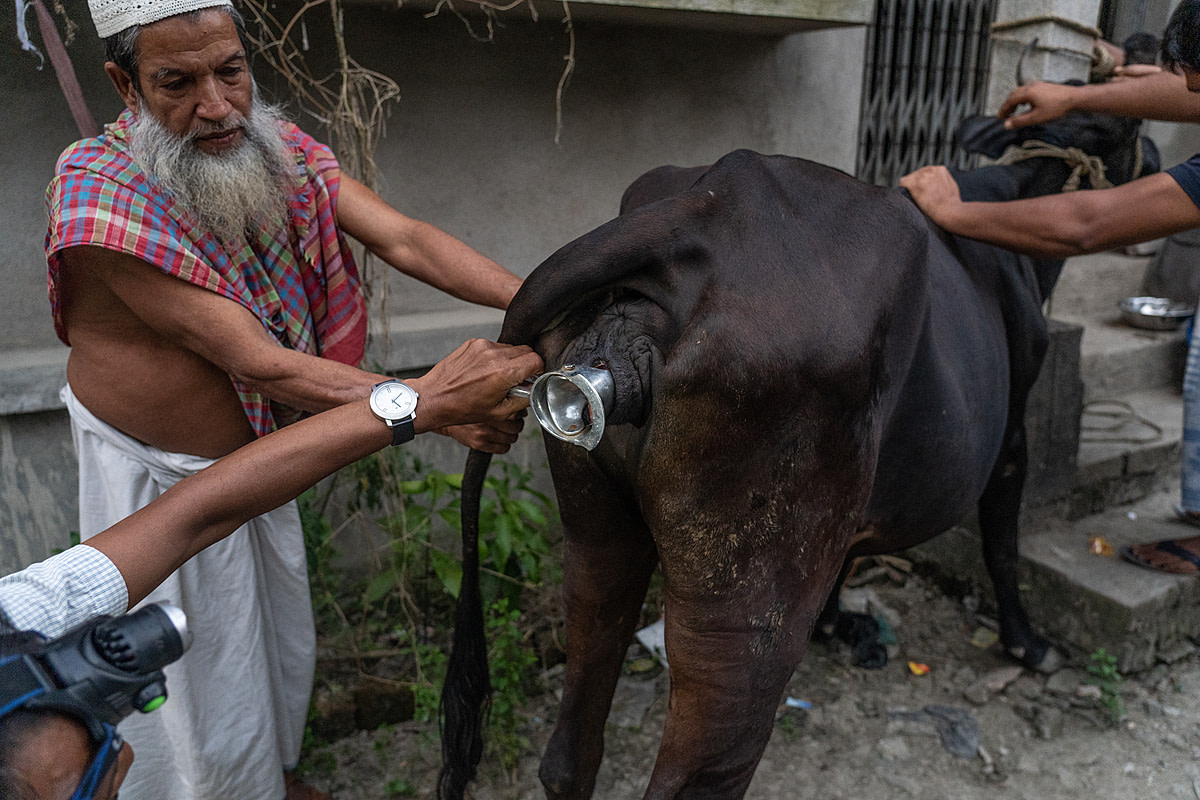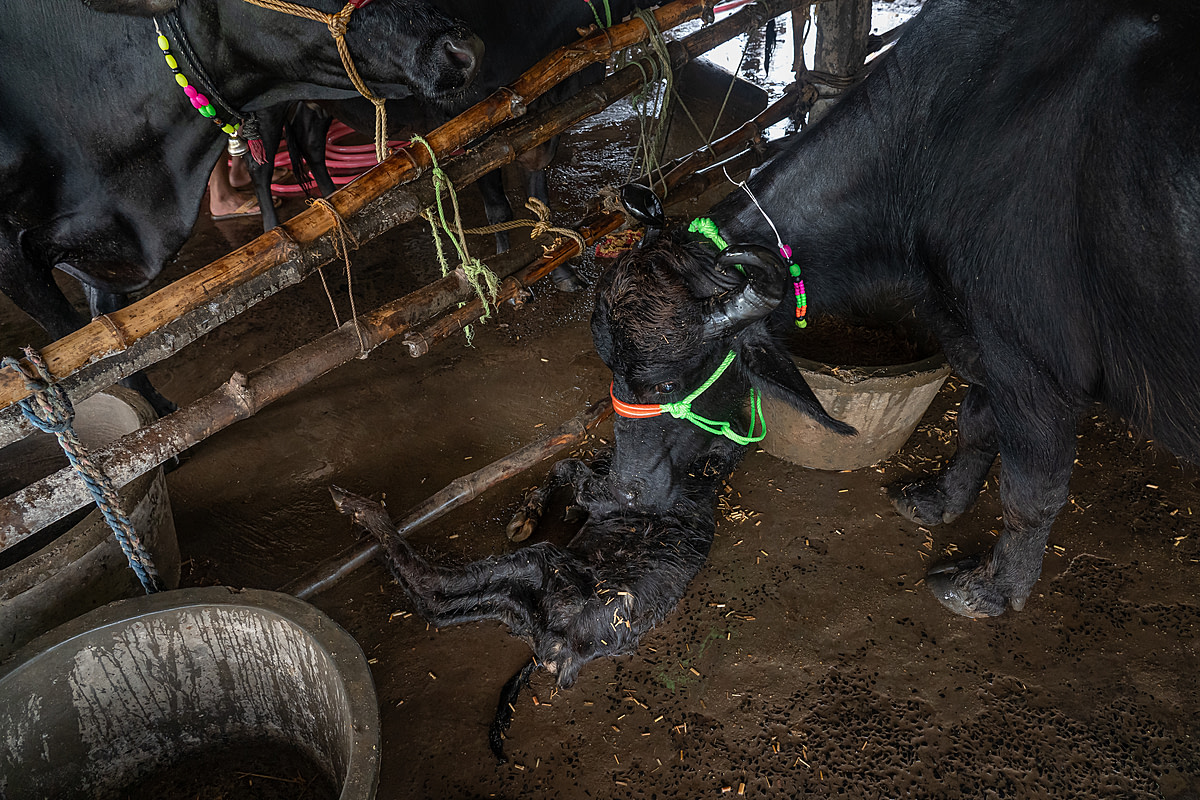Documenting Dairy Farming in India
Photographer and Videographer: Sudip Maiti
Author: We Animals Media
In collaboration with: FIAPO
Explore and download these visuals via our stock platform.
[Content warning: Contains upsetting images.]
Throughout 2023, We Animals Media teamed up with the Federation of Indian Animal Protection Organizations (FIAPO) to document a variety of animal industries throughout India, including aquaculture, chicken farming and the dairy industry.
As of 2023, India is considered the world’s largest producer of milk and is home to more than 300 million cattle and buffaloes, all of whom are used for milk production. Our photojournalist Sudip Maiti documented common practices on dairy farms in West Bengal, a state in northeastern India.
West Bengal is one of three states that account for approximately 30 percent of India’s dairy animals. Most of these animals live on small family farms, which face challenges of high feed costs and limited funds for appropriate infrastructure, factors which can contribute to poor standards of animal welfare.

A cow on a dairy farm tenses in distress as a veterinarian inserts a speculum into her vagina in preparation for an artificial insemination procedure. A total of four people were required to restrain her during this procedure. Dholahat, West Bengal, India, 2023. Sudip Maiti / FIAPO / We Animals Media

“Artificial insemination (AI) is the most common but traumatic experience for an animal to go through in this industry. When I visited the farm it was almost twilight and the owner informed me the cow was in heat. The local veterinary doctor explained to me that there was a small window of 8-12 hours in which the cow must be inseminated, and the process should be repeated every 1-2 years for maximum profitability. The AI gun was sterilized with lukewarm water and inserted without any lubricant. The cow had to be manually restrained by four people as it was an extremely painful process.” ― Sudip Maiti, animal photojournalist
Transport conditions & Dehorning
In Raina, a town in Bardhaman, dairy farmers import cattle and buffaloes from other states such as Punjab and Haryana, up to 2,000 kilometres away. Animals are often transported in tightly packed and highly uncomfortable conditions, sometimes with their legs bound for hours or even days. Calves can die during these journeys due to the rough transport conditions. Our photojournalist witnessed the bodies of several dead calves at this particular farm. According to the farmer, disposing of calves’ bodies is a nuisance due to the cost and labour required to bury the animals properly.

A young bull at a cattle market hangs in the air as two young men roughly lift him into the back of a truck by his ears and tail. Cattle are often transported in highly uncomfortable positions, with bound legs, for hours or days while tightly packed inside the transport vehicles with other cattle. Dholahat, West Bengal, India, 2023. Sudip Maiti / FIAPO / We Animals Media

Cattle struggle to find space for their heads as they lie in the back of a tightly packed transport truck at a cattle market. Cattle often suffer serious injuries and or may die during transport due to the severe overcrowding inside the vehicles. Dholahat, West Bengal, India, 2023. Sudip Maiti / FIAPO / We Animals Media
It is common practice in the dairy industry to dehorn cattle for safety and to reduce costs resulting from injury to other cattle and humans. Dehorned animals also require less space to house and transport, so more animals can be transported in one shipment. Cattle horns contain nerve endings, and the dehorning process is often very painful for the animals.
“Although it was explained to me that dehorning is a necessary procedure, I wish there could be a more humane approach to the problem. The cow was pretty distressed and it was evident in her behaviour. The lack of anesthesia seems to be for a budgetary reason. As I left the farm, I couldn’t help but wonder about the long-term effects of such violent methods on the animal’s psychological and physical well-being.” ― Sudip Maiti

Since 2023, Indian authorities recommend that veterinarians perform dehorning procedures with anesthestic. The procedure is, however, still performed regularly by untrained individuals without pain mitigation for the animals. Dehorning methods include using hacksaws, sharp wires, or blades to remove the horns. Complications and risks from these methods include sinusitis, uncontrolled bleeding, prolonged wound healing, fly contamination, bacterial infection and greater susceptibility to disease transmission, such as bovine leukosis (BLV) because of tool contamination.


Milk Production & “Khal bacha”
Like other dairy farms in India and around the globe, calves are separated from their mothers and are often fed silage from a young age rather than their mother’s milk, which the farm uses for dairy production. On this particular farm, calves’ access to their mother’s milk is restricted, resulting in what appeared to be hungry and malnourished calves.
If a calf dies while the mother is still lactating, some farm owners create a makeshift dummy calf from the skin of the dead calf with the help of some hay and a balm. Known as “Khal bacha” or “Khaal baccha”, this artificial calf resembles and smells like the mother’s deceased offspring. Placing the artificial calf next to the mother for approximately one month after she gives birth stimulates her body to produce oxytocin, which promotes a sustained milk flow. This traditional practice reputedly continues in several Indian states, including West Bengal, Jharkhand, Bihar, and Punjab.

“Today I experienced a mother’s love for her child. I visited a small privately-owned dairy farm in a remote location of West Bengal. I saw a calf’s skin made into a toy lying in the yard where the mother cow was tethered. The mother was very protective about the dead calf skin, and refused to move when we approached it.
After the shooting, when the owner placed the khal bacha near the mother cow, she immediately tried to lick the calf, trying to make sure that we were not taking her child away. She refused to eat while we were there, and the owner explained her main concern was for her child. She was nervous and visibly distressed by strangers, so I decided to leave the farm early.” ― Sudip Maiti


No matter where in the world you go, one truth will always be present: for every cow producing milk for human consumption, there is a calf somewhere going without – or one who was killed, considered nothing more than a waste product of this industry. These visuals offer a glimpse into the lived experiences of animals inside the farms of the world’s largest dairy producer.
A buffalo lies in the yard of a family-owned dairy farm, their ears flapping at flies. Bovines in this country’s dairy farms are usually not provided with cow mats. They must stand or lie on hard paved ground, contributing to the animals’ fatigue and joint deterioration. In the background, a line of other buffalos stands under a shelter. Dhatrigram, West Bengal, India, 2023. Sudip Maiti / FIAPO / We Animals Media
India, 2023. Sudip Maiti / FIAPO / We Animals Media
Data sources: USDA / GK Today / National Library of Medicine / Times of India
Images and video clips by Sudip Maiti.
Explore and download visuals from this assignment via our stock platform, which offers 20,000+ images and video clips for free to anyone helping animals.
Donate today and help us continue to produce compelling global investigations into these cruel industries.
More like this from We Animals Media:
Death by Heat Exhaustion: Inside India's Poultry Farms
by We Animals Media | Aug 30, 2023
From Source to Sale: Shrimp Farming and Fishing in India
by We Animals Media | Feb 2, 2023
In Photos: The Leather Industry with Christian Faesecke
by We Animals Media | May 30, 2022



